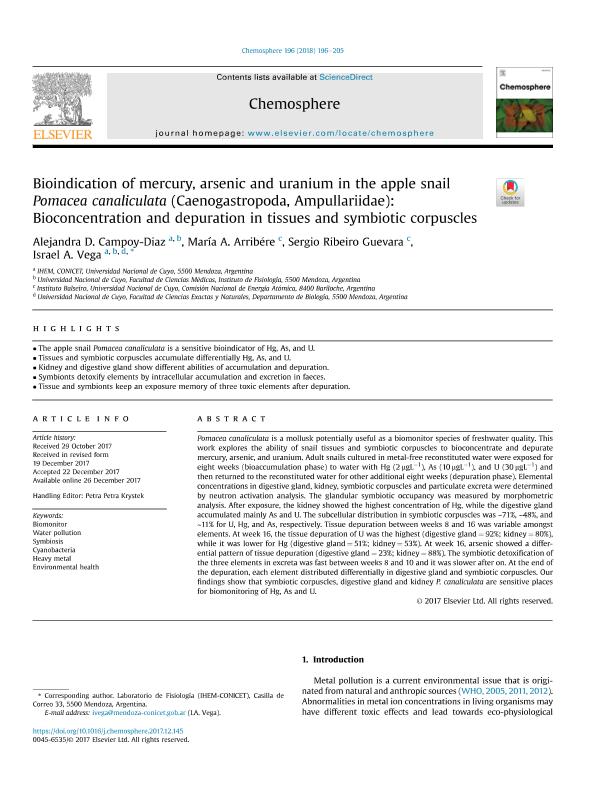Artículo
Bioindication of mercury, arsenic and uranium in the apple snail Pomacea canaliculata (Caenogastropoda, Ampullariidae): Bioconcentration and depuration in tissues and symbiotic corpuscles
Fecha de publicación:
12/2017
Editorial:
Pergamon-Elsevier Science Ltd
Revista:
Chemosphere
ISSN:
0045-6535
e-ISSN:
0045-6535
Idioma:
Inglés
Tipo de recurso:
Artículo publicado
Clasificación temática:
Resumen
Pomacea canaliculata is a mollusk potentially useful as a biomonitor species of freshwater quality. This work explores the ability of snail tissues and symbiotic corpuscles to bioconcentrate and depurate mercury, arsenic, and uranium. Adult snails cultured in metal-free reconstituted water were exposed for eight weeks (bioaccumulation phase) to water with Hg (2 μgL−1), As (10 μgL−1), and U (30 μgL−1) and then returned to the reconstituted water for other additional eight weeks (depuration phase). Elemental concentrations in digestive gland, kidney, symbiotic corpuscles and particulate excreta were determined by neutron activation analysis. The glandular symbiotic occupancy was measured by morphometric analysis. After exposure, the kidney showed the highest concentration of Hg, while the digestive gland accumulated mainly As and U. The subcellular distribution in symbiotic corpuscles was ∼71%, ∼48%, and ∼11% for U, Hg, and As, respectively. Tissue depuration between weeks 8 and 16 was variable amongst elements. At week 16, the tissue depuration of U was the highest (digestive gland = 92%; kidney = 80%), while it was lower for Hg (digestive gland = 51%; kidney = 53%). At week 16, arsenic showed a differential pattern of tissue depuration (digestive gland = 23%; kidney = 88%). The symbiotic detoxification of the three elements in excreta was fast between weeks 8 and 10 and it was slower after on. At the end of the depuration, each element distributed differentially in digestive gland and symbiotic corpuscles. Our findings show that symbiotic corpuscles, digestive gland and kidney P. canaliculata are sensitive places for biomonitoring of Hg, As and U.
Archivos asociados
Licencia
Identificadores
Colecciones
Articulos(IHEM)
Articulos de INST. HISTOLOGIA Y EMBRIOLOGIA DE MEND DR.M.BURGOS
Articulos de INST. HISTOLOGIA Y EMBRIOLOGIA DE MEND DR.M.BURGOS
Citación
Campoy Díaz, Alejandra Daniela; Arribere, Maria Angelica; Ribeiro, Sergio; Vega, Israel Aníbal; Bioindication of mercury, arsenic and uranium in the apple snail Pomacea canaliculata (Caenogastropoda, Ampullariidae): Bioconcentration and depuration in tissues and symbiotic corpuscles; Pergamon-Elsevier Science Ltd; Chemosphere; 196; 12-2017; 196-205
Compartir
Altmétricas




